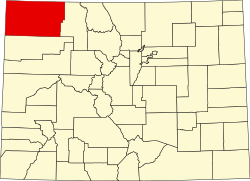History
Skull Creek was founded sometime between 1910 and 1954. The settlement was named after a nearby creek, which is also named Skull Creek. [1]
A dinosaur fossil, nicknamed "Zephyr", was discovered by construction workers nearby in 2019. [2] [3]
The post office in Dinosaur serves Blue Mountain addresses. [4]
This page is based on this
Wikipedia article Text is available under the
CC BY-SA 4.0 license; additional terms may apply.
Images, videos and audio are available under their respective licenses.
